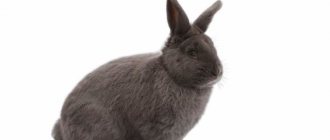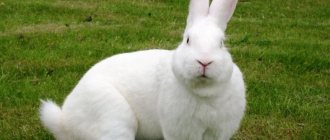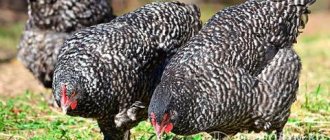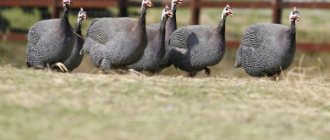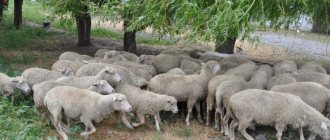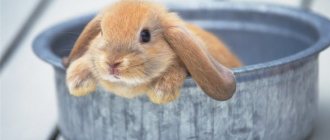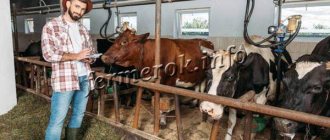Farms have a wide variety of slopes. Hardworking hands can realize here the cultivation of any living creatures and any plants within their climatic latitude. In this article, we will analyze in as much detail as possible such a bias as a rabbit farming business.
So , let's go! How to make money by breeding rabbits and not go broke.
Pros and cons of running a rabbit farming business
The advantages include the following points:
- Relatively low starting capital for a small farm;
- Short payback periods with stable sales markets;
- Rabbits reproduce... like rabbits;
- Keeping rabbits is cheaper than most animals per kilogram of live weight;
- To register this business you will need a minimum list of documents;
- The meat of these animals has a stable demand in the market;
- Additional income will come from selling rabbit skins and manure;
The disadvantages of this type of activity include the following:
- High mortality rate in case of savings on veterinary drugs;
- Strict sanitary requirements;
- When selling products to large chains, we receive only 50% of the payment for the products immediately, and the rest upon sale.
Additional sources of income
A good option to increase benefits for rabbit breeders is the sale of secondary products - skins and droppings.
Rabbit skins
Everyone knows that in addition to healthy meat, rabbits produce skins of the finest quality. Fur products made from rabbit are very popular and in demand in our market. In some regions, winters are quite cold, and a rabbit hat or fur coat will always protect you from the frost. And the cost of such clothes is several times cheaper than those made from the fur of other animals. Therefore, there will always be a buyer for the skins. Despite their low price, this is additional income.
Litter
Nowadays, we have begun to value natural organic products, in other words, those grown without the use of chemical fertilizers. But for normal growth and high yields, plants are still fertilized. For example, the same rabbit manure. You won’t be able to earn much from selling manure due to the small volumes, but you will get your contribution to the total income. In addition, it is possible to organize the production of vermicompost (concentrated liquid fertilizer obtained by fermenting manure), which is very much appreciated among farmers. You can get significantly more income from vermicompost.
Demand and competition analysis
Despite the high potential of the business, there is currently little competition in the rabbit meat market. The main reason for the slowdown in interest in rabbit meat is its price . But, due to the increasing interest in healthy eating, people’s demand for rabbit meat is still growing from year to year. Rabbit meat is a dietary meat, so it easily fits into the diet of the healthy lifestyle concept.
Before you decide to start a rabbit farm, you should take care of the markets . Simply put, if you can't sell your products at the right price, is it worth starting?
Is it profitable to breed eared animals?
It is believed that it is more profitable to breed and sell pigs and other animals, and the profitability of rabbit farming is lower than in other areas of livestock farming. This is a controversial statement:
- The more widespread a product is, the lower its prices. Rabbit meat, on the contrary, is rare meat, its prices are higher, and, therefore, profits too.
- As a rule, little is spent on keeping rabbits. Moreover, over the course of a year, the animal increases its weight by about 50 times and multiplies quickly.
- Rabbits provide meat, fluff and other products. You can also make money from this.
During Soviet times, the industry was developed, but in the 90s it fell into decline. Abroad, rabbit meat, on the contrary, is popular today.
In Russia, industry pioneers earn more money due to low competition and high product prices.
The profit from the sale of each rabbit depends on the breed and age. Young animals for the farm are usually bought for 400–450 rubles.
There are other ways to make money from breeding rabbits. Additional “bonuses” include:
- Skins, even obtained from meat breeds.
- Litter. It is bought to fertilize the soil. Although much more expensive, vermicompost is a liquid product obtained after fermentation of manure in special equipment.
- Fresh waste after slaughter. They are bought by pig farmers to feed livestock.
- Sale of “extra” heads, young animals.
- "Rent" of breeding males.
We determine sales markets
The main markets for rabbit meat are hypermarket chains and small butcher shops . A category of potential consumers has already been formed here, for whom the quality of the product and its regular supply are primarily important.
You can also offer cooperation to restaurants , but it is worth discussing this matter directly with the chef, who will be able to appreciate the quality of your meat and include it in his menu.
We should not forget about word of mouth, which is one of the best options for creating your own customer base and good reputation.
Therefore, at the first stages of your steps in this business, you should monitor the availability of the pricing policy in order to attract more customers.
Calendar plan
On a rabbit farm, it is important to do everything on time. The monthly calendar plan for the middle band looks something like this:
- January. Feed is given in maintenance quantities. Females are culled. Young animals for slaughter begin to be fed tightly from the 20th.
- They prepare the animals for mating and check their condition. Young animals from 4 months of age are slaughtered.
- Pairing. The female rabbits are placed with the males.
- They get offspring.
- May. In the second half, a second mating takes place. For new rabbits, the feed intake is increased. When they are 1.5 months old, they are separated from their mother.
- In the third decade, female rabbits give birth. April juveniles are kept in the same way as adults.
- At 3–4 months of age, rabbits sometimes develop coccidiosis. They monitor their condition and, if necessary, contact a veterinarian.
- Mating takes place at the end of August. In the middle of the month - the slaughter of the first litter, a little later - the placement of the second.
- Childbirth again. Artificial lighting is used, providing daylight hours of 14 hours.
- The males are resting. Female rabbits care for their young.
- The young are slaughtered again. Females go on “winter holidays”.
- December. The rabbits are fed more actively and slaughtered at the end of the month.
Deciding on a breed for breeding
Promising breeds of rabbits:
- Strokach. These rabbits do not have a long thick neck and a muscular body. They grow quickly, so when they are 8 months old they are sent to slaughter.
- White pannon. These are large rabbits with an average weight of 5 kg and a snow-white coat. In one litter, a female of this breed gives birth to 9 babies.
- Flanders These rabbits are gray in color and have an arched back. Although they grow very slowly (they are ready for slaughter no earlier than 9 months), their weight reaches up to 12 kg.
- California rabbit. A red-eyed animal with a memorable white color. Thanks to their lightweight bones, they produce a lot of meat.
- Gray giant. They are precocious and fast-growing rabbits, which by 2 months already weigh 3 kg. The slaughter yield is up to 55%.
- White giant. This breed of rabbit has an immaculate white coat, but relatively poor health. Therefore they need special care.
- Soviet chinchilla. It is distinguished by high-quality thick silver-gray fur and rapid growth rates. However, they can be sent for slaughter only at 5-9 months of age.
- New Zealand rabbit. This breed is not high maintenance. They have shiny thick white fur.
- Ober. Rabbits of this breed can produce both juicy meat and high-quality skins.
- Hicol. The meat of this breed is excellent for baby food, as it has little fat.
Acquisition of the younger generation
The first step (after building or acquiring a farm) in the development of a rabbit farm is the purchase of young stock. Before purchasing pets, you need to decide on the breeding goals:
- Obtaining skins;
- Receiving meat;
- Dressing of hides and meat.
The direction of cultivation affects the characteristics of care, equipment, feed, and investments.
Raising rabbits for meat involves choosing specially bred breeds: gray and white giants, silver rabbits, chinchillas. Meat breeds quickly gain weight (up to 2 kg in 2 months).
In the skin direction, when selecting a breed, they focus on the quality of the fur. The most expensive fur coats are obtained by breeding Alaskan, Thuringian and fiery black rabbits. These breeds are quite rare, but the most valuable. Keeping rabbits of the skin type is quite expensive and not always profitable. Representatives of breeds with valuable fur require careful care, compliance with feeding standards in order to maintain the quality of the fur coat, and maintenance in separate enclosures. When dressing skins, a carcass remains, the quality of which is not suitable for sale.
There is a purebred method of breeding rodents. In this case, representatives of the same breed are purchased in order to increase the quality of products and enhance the valuable qualities of young individuals.
To multiply investments and run a profitable business, breeding rabbits must be thought out in advance. Recommended meat and skin breeds. Rapid weight gain, high-quality fur and ease of care create favorable conditions for the development of entrepreneurship. Starting with a small number of individuals, the most suitable breed is selected experimentally.
To start production, a pair of adult rodents is purchased. Females of the meat and meat-skin production produce fairly large offspring, which helps business development. When choosing a rabbit, pay attention to the appearance and health status of the rodents. Contact of sick individuals with healthy ones is unacceptable; it can lead to death.
Preparation of necessary documents
In the rabbit farming industry, it is mandatory to register your business. You can register your business in three ways: Peasant farm (peasant farm), and individual entrepreneur (IP) and personal subsidiary plot.
- Peasant farm . The advantage of this form of ownership is state support in the form of subsidies and preferential conditions . With this registration, you will act as an individual entrepreneur, but with a limited list of rights. It includes only that category of people who have the right to any economic activity. If you run a medium-sized business focused on domestic rabbit breeding, then this form will suit you perfectly.
- Individual entrepreneurship . This is a simple and convenient form of doing business with a large list of possibilities. You can easily move from a small farm to a large livestock complex. In taxation, you can use the unified agricultural tax or a simplified system.
- Personal subsidiary farming . This is the most economical design option in this business. It has the advantage of no taxation on the sale of meat. To obtain this status, you only need to provide a certificate of ownership of a summer cottage. You can get it from compulsory medical insurance. However, if you are planning rabbit breeding on a large scale, then this type of design will not suit you. You will not be able to sell your product in hypermarkets and restaurants, and there will also be a limit on the quantity of products sold.
To obtain a sales permit, you need to prepare the following package of documents:
- Sanitary book
- Certificates from a veterinarian confirming the absence of diseases in rabbits
- Certificates from laboratories where the tests were carried out
- Sanitary certificate of a vehicle for transporting rabbit meat.
The rabbit breeding business involves the purchase of equipment for keeping rabbits. There are three main ways of keeping them: semi-free, aviary and the most common - the cage system. The cellular system is the most convenient for maintaining veterinary requirements and sanitary standards.
Tax form
For the agricultural sector there are two forms of taxation. This is a Simplified view, where income minus expenses and Unified Agricultural. Which one is more convenient for you, you can ask advice from a person involved in accounting activities. Because it depends on the form of activity, on the number of employees and on the volume of production.
Upon registration, you will be assigned an OKVED code with encoding - A.01.25.2. This means: raising rabbits and fur-bearing animals on a farm. This code does not include meat and skins of animals obtained by hunting or trapping.
Preparing the premises and equipment
To prepare a room for rabbits, you need to remember that they are afraid of sudden changes in temperature. The optimal air temperature should be 12C-18C. High or low humidity should also not be allowed. It is desirable that sunlight enters the room. Drinkers and feeders are installed along the walls.
It is recommended to make a room for storing inventory tools indoors. Some farmers set up a place for feed. A manure storage facility is being built separately.
Sheds for rabbits
The shad system is excellent for raising rabbits. This is a free-standing, enclosed space that blocks out direct sunlight and high temperatures while allowing fresh air in.
The shed system is a complex structure that includes cells arranged in a vertical or cascading manner. To maintain heat, it is necessary to maintain a distance of at least 70 cm from the floor of the lower cages to the ground.
When using this system in suitable climatic conditions, it will practically not differ from natural ones. Rabbits will be able to lead a more free and active lifestyle, and farmers will spend less time and effort. A characteristic feature of this method is the most rational use of space .
The disadvantage of this system is heating in cold winters and feeding rabbits with warm water.
In order to avoid outbreaks of diseases and infections, it is recommended to regularly clean the cages and also disinfect them. Disinfection is carried out at least once every six months. Mainly in spring and autumn, as well as unscheduled after the end of diseases in the herd or their upcoming reproduction.
For disinfection, strong antiseptics for the inside and outside of the cells, followed by washing them with fresh water.
Face shop
Rabbits are slaughtered in specially equipped premises - slaughterhouses. It includes a slaughterhouse, utility room, refrigerators and dryers. This room must meet all hygiene standards. Walls and floors must be lined with materials suitable for washing and disinfection .
Rabbits are processed on carousel-type units, at mechanized slaughter stations and on mechanized flow lines.
Methods of slaughtering rabbits: electric stunning, a blow to the back of the head with the edge of the palm, a blow to the forehead or nasal bone with a stick. The rabbit's death occurs instantly.
Based on the slaughter weight of a rabbit, its meat productivity is assessed. The older the rabbit, the higher the slaughter weight.
Refrigeration equipment
Product storage conditions are a fundamental part. Therefore, special attention . It must maintain the correct temperature, maintain the desired level of humidity and maintain proper air exchange.
The following types of refrigeration chambers are distinguished:
- cooling chamber
- blast freezer
- for long-term storage of the product
- freezer for meat with temperatures from -25C to -40C.
Industrial refrigeration chambers for storing meat are controlled automatically .
Manure storage
Typically, manure heaps are formed using metal square molds without a bottom, approximately 3x3 meters with a crane hook. After filling, the form is moved to another place and the cycle repeats. Rabbit manure is the most optimal for fertilizer. A year later, the pile is ready for sale.
How to make a cage using the Mikhailov method with your own hands according to a drawing with dimensions?
The farm consists of several compartments. It includes:
- - nest compartment;
- - for young animals;
- - hood;
- - heating for the nest;
- - feeders;
- - drinking bowls.
The scheme of the Mikhailov
Cell system is built in several tiers:
The first tier is the stand. It rests on four posts. The racks are made of strong beams. The supports of the upper tiers consist of beams.
A stand frame is adapted to support the structure. It has compartments for electrical equipment and tool storage. There is also a ladder and a barrel for feces on it. It is better to assemble it from a material that does not rust. Below are drawings of a rabbit cage with dimensions according to the Mikhailov method.
Mikhailov system drawing
The middle tier is located on the stand. It is intended for walking animals and a maternity ward. With the help of racks, the tier rests on a stand. The dimensions of the racks are 2*10 cm. On the east side the hole is covered with a mesh. There is a window 250*250 mm in the mesh. On this tier there is a trap for control and jigging, as well as shelter.
The farm is divided into several sections. The bunker feeder and automatic drinker are located in the walking compartment. A 20*30 cm gap is made from the bottom. It leads into the slope mines. Deflected 100 mm to the right. This makes it combined with the lower compartment on the ground floor. The flooring is inclined at 45°. Rats are protected from metal strips.
The bottom is filled with 2*45 cm slats. Poop falls into the gaps and the cage is always clean.
The design includes a pipe for ventilation. Thanks to this, gases do not accumulate inside.
The nesting compartment has a door that opens up. When it is open, it turns out to be a table for working with kids. This compartment has a solid floor. It is located a little lower level. External walls are insulated. The hole is closed with a view on the south side.
Since the queen cell is made removable, there are gaps on the sides. To prevent animals from entering this hole, they are covered with planks. It is better to make a metal damper that blocks the nest. The door is made of wood.
On the upper tier there are growing rabbits. A separate section was made for the male. She protrudes beyond the frame.
The water container is located between the compartments on the front wall. Moisture comes into it automatically from other containers that are located outside on the wall of the walking compartment. To keep the water warm in cold weather, it is heated with a boiler.
Next to the drinking bowl there is a bunker feeder. A recycler has been added to it. When rabbits rake out hay, crumbs fall into it. The crumbs can be reused. The top of the feeder is folding. When you need to put in the next portion of food, it opens.
For hay and root crops, feeders are located between floors. The heavy lid pushes the food down.
It’s a complex design, but having built one with your own hands, the rest will be easy to do. After you try it at work, transfer the rest of the animals to such cages. After all, it is easy to work with animals in such cages, and they, in turn, feel great.
Let's talk in more detail about organizing a rabbit farm.
Purchasing rabbits
If you have decided on the breed of rabbits, then the next step is to purchase them. To do this, find good nurseries where the breeds you are interested in are bred and see in what conditions they are raised. Make sure you buy quality young stock.
To determine high-quality, healthy and, most importantly, fertile rabbits, we suggest you familiarize yourself with our tips:
- To avoid inbreeding and genetic diseases, you should not take a female and a male from the same litter.
- Do not buy rabbits if there are wounds on the inside of the rabbit's ear. They may be a sign of ear mites.
- Obese rabbits are not prone to active reproduction
- Do not take pregnant females; after transportation and the resulting stress, they may develop serious health problems.
Please note that prices can vary greatly depending on the eliteness of the rabbit breed, but you should not save on purchasing livestock . Farmers at the initial stage begin with the purchase of adult individuals in order to quickly receive offspring and reduce the time it takes to make a profit.
Useful tips for beginners
It is useful for novice rabbit farmers to study the recommendations of experienced breeders.
Professionals advise following the following instructions:
- Outdoor pens must have canopies.
- Make wooden slatted floors in cages, wrapping them with metal profiles.
- It is better to choose a design that allows you to give food and pour water into the drinking bowls without opening the door.
- Rabbits should be fed hay year-round.
- Protein in the diet should be 14–20%. Average indicators (16%) contain mixed feed.
- Be sure to vaccinate your rabbits.
- To keep the meat clean, animals need to be fed hay, root vegetables and vegetables.
- After giving birth, the female and her offspring need to be given a lot of attention.
Breeding rabbits on a mini-farm is a promising and profitable type of business. With proper organization and arrangement, the breeder can expect offspring with minimal mortality and good growth of adults, the carcasses and fur of which will bring financial profit.
Procurement of feed
Rabbits are finicky animals when it comes to food. For feeding you will have to use a complex of substances. It includes: feed, fruits and vegetables, hay and grains, as well as nutritional supplements of vitamins and minerals.
The daily norm for an adult rabbit is 100 g of feed . If you use a mixed type of feeding, then the feed rate is halved. The fertility of your rabbits will depend on a properly formulated diet, because as we know, obesity reduces their fruitful activity.
Feed is one of the main expenses, so many farmers want to reduce it. Considering that purchased feed is quite expensive, you can make it yourself. To do this you will need grain, grain waste, a grain crusher and a granulator. The concentrate feed has three different recipes, as separate feeds for adult rabbits and young animals, as well as for rabbits of all ages.
The value of rabbit meat
Rabbit meat has advantages over its analogues that ensure competitiveness - especially if they are skillfully used during promotion:
- Great taste. There are many delicacies made from rabbit meat in the culinary world.
- Increased protein, low cholesterol. Absorbed by 90%, improves metabolism.
- The product is considered dietary. It contains very small amounts of sodium salts.
- The meat contains all amino acids, vitamins and minerals (C, PP, B12, B6, phosphorus, iron, calcium, manganese).
- It contains lecithin, which is useful for the prevention of atherosclerosis.
Rabbit meat helps strengthen bones, normalize blood sugar levels, and comprehensively strengthen the body.
Staff
For constant high-quality work, the rabbit breeding farm has an entire production team. It includes:
- Working operator. A person who monitors the life and health of rabbits.
- Slaughterer. A person who kills and butchers rabbits, and packages and places them in refrigerators.
- Vet. The doctor monitors all sanitary and veterinary measures.
- Engineer. He monitors the proper operation of equipment and repairs it.
- Other workers. These include an accountant, a driver and a cleaner.
What expenses will the entrepreneur incur?
The answer to the question “Is rabbit breeding profitable or not as a business” lies in the expense column. If we take into account a plot with an area of 800 square meters, then its rent will cost 2 thousand. It will cost from 300 thousand rubles a year to maintain 600 rabbits. Before this, you will need to build a building, purchase cages, draw up documents and purchase the rabbits themselves.
| Documentation | 5000 |
| Construction of a building and digging a hole | 200000 |
| Sheds, 30 pcs. | 600000 |
| Cages, 600 pcs. | 600000 |
| Rabbits, 600 pcs. | 300000 |
You need to set aside another 100 thousand rubles for unforeseen expenses.
Profitability of rabbit farming
Profitability shows our economic efficiency. Since our business plan showed that to open a small rabbit farm we will need about 600,000 rubles . Now it’s worth calculating the income from our farming business.
- With regular slaughter and maintaining a livestock of 1000 rabbits, the meat yield per year is about 4 tons.
- On average, the price for 1 kg of meat is from 300 rubles.
- expenses for employee salaries, feed and utilities will amount to 800,000 rubles/year.
- Average revenue will be 1.2 million/year.
Thus, we will receive a net profit of 400,000 rubles.
In this situation, the rabbit breeding business will be able to fully pay for itself in just 2 years and we will begin to receive a stable net profit.
Sales of products
Industrial production of rabbit meat in Russia is still at the formation stage. However, the demand for meat is high and remains largely unsatisfied. Experts predict an increase in rabbit meat consumption by approximately 1-2% per year.
The manufacturer has several sales channels for the product.
Firstly, forming your own client base. We are talking about the farmer’s own acquaintances, his family’s acquaintances, and so on. Word of mouth is important, especially if you offer meat inexpensively.
You also need to place advertisements in newspapers and on the street. This way an entrepreneur can create his own base of regular customers.
The second channel is sales through stores. We are talking about retail stores and small chains. You can sell meat to restaurants.
Mini home farm format
To build your own small farm, first of all you need to find out from the local administration how far the farm should be from residential buildings. This knowledge will help you avoid getting fined in the future.
Small hillocks are considered the best place for construction . During rainy summer-autumn periods, and when the snow melts in spring, water will not accumulate. As we wrote earlier, rabbits do not like high humidity. The best option would be to concrete the area.
The area of the site must be at least 700 m2 and have an uninterrupted power supply.
Three necessary structures need to be built on the site:
- Shed system (cages for rabbits)
- Refrigeration and slaughterhouse space
- Utility room
- Well for water supply
In mini-farms, caring for and maintaining rabbits takes a small amount of time and does not require much effort.
Cutting shop
The time for slaughtering rabbits comes very quickly due to the extraordinary precocity of these animals. You should prepare for this moment in advance by equipping a workshop where the slaughter and cutting of rabbits will take place. Mini-slaughterhouses for these animals are available for sale. They meet all the necessary requirements of existing standards and have a certification document.
They have the possibility of expanding the line with an increase in the number of animals. When fully loaded, there is a quick payback. If you want to start a rabbit business, you should take care of this equipment in advance, and include the costs in your business plan.
Business risks
- The fundamental risk in the rabbit farming business is the high mortality of animals. This occurs due to various infectious diseases and viruses, which leads to mass death of rabbits. This problem is solved through animal vaccinations.
- The second point may be their weak digestive system. Since rabbits do not know when to eat in moderation, their body may simply not be able to cope with it. Overeating will lead to bloating and subsequently death. To avoid this, you need to approach the issue of feeding wisely.
Skin dressing
No one can kill a rabbit the first time and get a whole beautiful skin. This must be learned and preferably from the old and sick, from whom it is impossible to benefit.
In theory, the process is simple: after the blood has drained from the carcass, cuts are made on the joints of the hind legs and the skin is pulled off. But this must be done carefully, without stretching, otherwise the fur will deteriorate and tears will appear.
After removing the skin, the following manipulations are carried out:
- Soaking it in water at room temperature with added salt. If possible, experts recommend pressing them down.
- Cleansing of fat, muscles and ligaments. It is put on the nozzle and the excess is scraped out with a knife. It is important to choose a small base to prevent stretching.
- Pickling - processing in a solution with acids.
- To consolidate the result and protect the skin from water, it is tanned: rubbed with willow decoction from the inside.
- Fatting is rubbing the skin with a solution of laundry soap and animal fat. This gives elasticity and softness to the fur.
After this, everything is dried, combed and delivered to the customer. To maintain quality, you cannot skip any of the stages and follow the technology.
Along with paws, tails, and ears, by-products include skins that have not passed certification. During the dressing process, most of them are damaged and they cannot be sold at a favorable price. But this is not a reason to throw them away. The following materials are created from spoiled skins:
- different types of leather: chrome, velor, suede or lycra;
- lining for outerwear;
- creating imitation crocodile skin for accessories;
- felt for felt boots and hats.
Other by-products such as paws, tails and ears are used to create souvenirs and keychains.
Where to sell?
Let's now talk about selling the resulting products. Its directions should be considered based on the volumes of the future economy. If they are small (about 500 rabbits annually), the meat can be sold for sale or sold independently, subjected to a sanitary and epidemiological inspection.
For large farm volumes, you will need to obtain some additional documents. We are talking about a farm certificate, the same phytosanitary one, and a GOST-R declaration. If you complete all of the above, at the same time as trading at the market, you will have the opportunity to sell meat to a network of supermarkets and grocery stores.
What should be on your site
The next step of the rabbit breeder businessman will be to compile a list of buildings whose presence on the site is mandatory. Each of them should be placed on the plan of the site allocated for the future company. What applies to such buildings?
- Sheds. This is the name given to the premises where rabbits will live and breed. Such “industrial” rabbit hutches are made from wood with windows covered with welded mesh. The more comfortable the rabbits are in the sheds, the better the breeding process will be, and the less fear the owner will have for the health of the pets. The minimum number of sheds is 3 pieces.
- Feed workshop. This is a kind of warehouse where food for rabbits can be stored for the next few months. If you spare no expense and equip your feed shop with a granulator and a grain crusher, the costs will quickly pay off.
- The slaughterhouse premises must have a fully equipped meat shop and a spacious refrigerator. Due to high hygiene requirements, the materials for its construction are metal-plastic and tiles.
- Tools, equipment and necessary building materials should be kept in a separate shed.
A spacious manure pit should be dug not far from the site. With regular replenishment, it is possible to sell manure as fertilizer to surrounding farmers.

